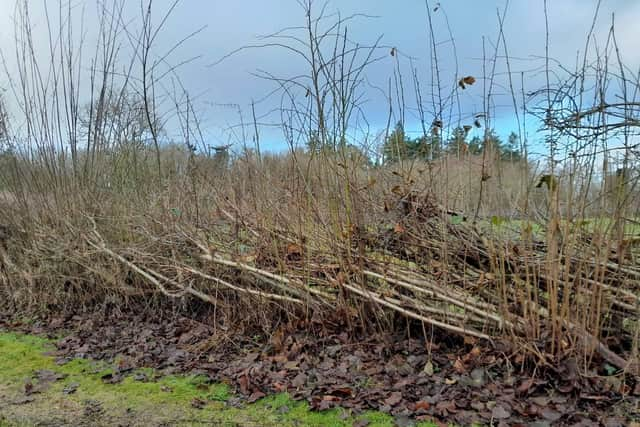CAFRE to host hedge-laying courses
and live on Freeview channel 276
These are hands-on one day introductory courses that aim to demonstrate the skills and techniques involved with laying a hedge.
Robert Beggs, CAFRE technologist explains: “Hedge laying is the traditional method of rejuvenating hedgerows to maximise the shelter and biodiversity opportunities that hedges provide on NI farms. Hedges are particularly important due to the low proportion of woodland in Northern Ireland. Hedges enhance the appearance of the countryside, maintain our traditional field boundaries and provide a valuable habitat for a variety of plants and animals.”
Advertisement
Advertisement
Hedge laying involves partially cutting the stems of the hedge plants and laying them uphill at approximately 30 degrees. The hedge produces new growth from the base and the laid stems continue to grow over the medium term. This results in a thicker hedge that is better for biodiversity, shelter and is more stockproof.


Ideally hedge laying should be carried out every 15-30 years and is best suited to hedges that are 2.4-3.6m tall and have stems that are 50-100mm thick at the base. Ash or hazel stakes are then driven in at intervals to support the laid hedge.
Due to the practical nature of these events, places are strictly limited so registration is essential. Anyone interested in attending should visit the environmental training courses section of the CAFRE website and apply: www.cafre.ac.uk/business-courses/hedge-laying/
These are hands-on one day introductory courses that aim to demonstrate the skills and techniques involved with laying a hedge.
Advertisement
Advertisement
Robert Beggs, CAFRE technologist explained that: “Hedge laying is the traditional method of rejuvenating hedgerows to maximise the shelter and biodiversity opportunities that hedges provide on NI farms. Hedges are particularly important due to the low proportion of woodland in Northern Ireland. Hedges enhance the appearance of the countryside, maintain our traditional field boundaries and provide a valuable habitat for a variety of plants and animals.”
Hedge laying involves partially cutting the stems of the hedge plants and laying them uphill at approximately 30 degrees. The hedge produces new growth from the base and the laid stems continue to grow over the medium term. This results in a thicker hedge that is better for biodiversity, shelter and is more stockproof.
Ideally hedge laying should be carried out every 15-30 years and is best suited to hedges that are 2.4-3.6m tall and have stems that are 50-100mm thick at the base. Ash or hazel stakes are then driven in at intervals to support the laid hedge.
Due to the practical nature of these events, places are strictly limited so registration is essential. Anyone interested in attending should visit the environmental training courses section of the CAFRE website and apply: www.cafre.ac.uk/business-courses/hedge-laying/